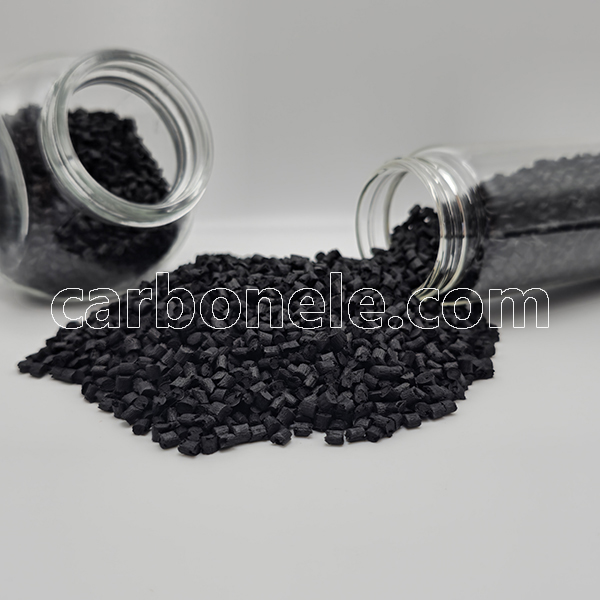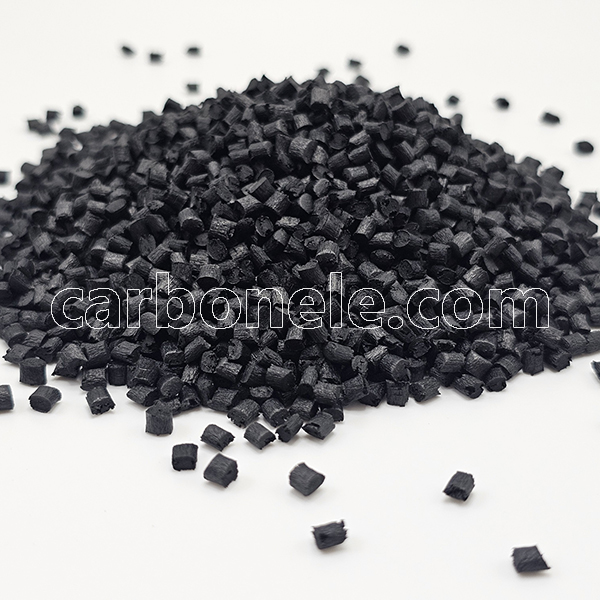
High Rigidity PA6 CF40 Thermoplastic Composites For Auto Parts
PA6 CF40 composites are advanced materials that consist of Polyamide 6 (PA6) reinforced with 40% by weight of Carbon Fiber (CF). These composites are engineered to provide exceptional mechanical properties, making them suitable for a wide range of demanding applications across various industries.
- Model: PA6-CF-BCA4
- Manufacturer: Yes
- Filler: Carbon fiber
- Color: Black
- MOQ: 1000kgs
- Free sample: Available
- Grade: Virgin
What’s PA6 CF40?
PA6 CF40 refers to a composite material where Polyamide 6 (PA6) is reinforced with 40% by weight of Carbon Fiber (CF).
This composition results in a high-performance material specifically tailored for demanding applications in the automotive industry. Here’s a detailed look at PA6 CF40 composites and their applications in auto parts:
Characteristics of PA6 CF40 Composites
1. Exceptional Strength and Stiffness:
– PA6 CF40 composites exhibit significantly enhanced tensile strength and stiffness due to the high loading of carbon fibers.
– They offer superior mechanical properties compared to standard PA6, making them suitable for structural components that require high strength and durability.
2. Lightweight:
– Despite the increased reinforcement, PA6 CF40 composites remain lightweight.
– This property is crucial for automotive applications where reducing vehicle weight contributes to improved fuel efficiency and performance.
3. Excellent Dimensional Stability:
– PA6 CF40 composites demonstrate improved dimensional stability and resistance to deformation under varying temperature and humidity conditions.
– This ensures consistent performance and durability of auto parts over their lifespan.
4. Heat and Chemical Resistance:
– PA6 CF40 retains the excellent heat resistance and chemical resistance of PA6, with added durability against automotive fluids, oils, and fuels.
– This makes them suitable for under-the-hood applications where exposure to high temperatures and harsh environments is common.
5. Impact Resistance:
– While stiffness is increased, PA6 CF40 composites typically retain good impact resistance, ensuring reliable performance in crash-prone areas of automotive design.
6. Electrical Conductivity:
– Depending on the type of carbon fiber used, PA6 CF40 composites may exhibit electrical conductivity.
– This property can be beneficial for applications requiring electromagnetic interference (EMI) shielding or static dissipation.
Applications of PA6 CF40 in Auto Parts
1. Under-the-Hood Components:
– Engine Components: PA6 CF40 composites are used in engine mounts, valve covers, intake manifolds, and other structural parts due to their high strength and heat resistance.
– Cooling System Components: Radiator end tanks, coolant pipes, and thermostat housings benefit from the material’s dimensional stability and resistance to automotive fluids.
2. Structural Components:
– Chassis and Suspension Parts: PA6 CF40 is employed in chassis components such as brackets, reinforcements, and structural members to enhance rigidity and reduce weight.
– Body Panels and Trims: Lightweight body panels, door panels, and interior trims benefit from PA6 CF40’s strength-to-weight ratio and aesthetic appeal.
3. Electrical and Electronic Components:
– Connectors and Housings: PA6 CF40 composites are used in electrical connectors, sensor housings, and wiring harness components due to their electrical insulation properties and durability.
4. Transmission and Drivetrain Components:
– Gearbox Housings: PA6 CF40 is utilized in gearbox housings and transmission components where strength, stiffness, and resistance to heat are critical.
– Drive Shafts and Bearing Supports: These components benefit from the material’s high mechanical performance and wear resistance.
5. Interior Components:
– Dashboard Structures: PA6 CF40 composites are used in dashboard supports and structural elements to reduce weight while maintaining structural integrity.
– Seat Frames and Headrests: Lightweight yet strong seat frames and headrests enhance comfort and safety in automotive interiors.
PA6 CF40 composites play a crucial role in advancing automotive technology by offering lightweight solutions with enhanced mechanical properties. They contribute to improving vehicle performance, fuel efficiency, and overall durability while meeting stringent automotive industry standards.
Content Block 1
Morbi iaculis at quam vel faucibus. Ut semper ipsum ex, quis aliquet justo pretium a. Suspendisse scelerisque metus augue, a interdum leo iaculis sed. Vivamus sit amet nunc odio. Duis vel pulvinar dolor, at lacinia tellus.
Pellentesque habitant morbi tristique senectus et netus et malesuada fames ac turpis egestas. Suspendisse lacinia quam a elit lobortis tempor


Content Block 1
Morbi iaculis at quam vel faucibus. Ut semper ipsum ex, quis aliquet justo pretium a. Suspendisse scelerisque metus augue, a interdum leo iaculis sed. Vivamus sit amet nunc odio. Duis vel pulvinar dolor, at lacinia tellus.
Pellentesque habitant morbi tristique senectus et netus et malesuada fames ac turpis egestas. Suspendisse lacinia quam a elit lobortis tempor

Frequently Asked Questions
Carbon (Xiamen) New Material Co., Ltd. aims to provide buyers with "one-stop" worry-free high-quality services. Here you can find all information about carbon fiber engineering plastics. If you still have questions, please send us an email for consultation!
-
How can I contact the manufacturer of a product that interests me?
When you find a product you are interested in, you can contact the manufacturer directly by sending an email and we will get back to you as soon as possible.
-
How do I find the products that interest me?
All you need to do is enter the keyword, product name in the search window and press the Enter key on your keyboard. Your search results page will then be displayed. You can also search within the product category pages on the home page. Each category is divided into subcategories, allowing you to refine your search and find products that interest you.
-
Where will I find a buying guide?
Please contact our after-sales service directly and we will provide you with a comprehensive operating guide.
-
What are CF Reinforced Thermoplastic Composites?
CF Reinforced Thermoplastic Composites are materials where carbon fibers are incorporated into a thermoplastic matrix. They combine the strength and stiffness of carbon fibers with the processability and recyclability of thermoplastics. For instance, they are used in automotive parts like bumper beams.
-
What are the benefits of CF Reinforced Thermoplastic Composites over traditional composites?
The key benefits include faster production cycles, easier recyclability, and better impact resistance. They also offer design flexibility. An example is in the manufacturing of consumer electronics casings where complex shapes can be achieved more easily.
-
How are CF Reinforced Thermoplastic Composites processed?
Common processing methods include injection molding, extrusion, and compression molding. Injection molding is widely used for mass production. For example, in the production of small components for the medical industry.
-
What industries use CF Reinforced Thermoplastic Composites?
They are utilized in aerospace, automotive, medical, and sports equipment industries. In aerospace, they can be found in interior components. In the medical field, they might be used in prosthetics.
-
How does the carbon fiber content affect the properties of the composites?
Higher carbon fiber content generally leads to increased strength and stiffness but may reduce ductility. A moderate content is often balanced for specific applications. For example, a higher content might be preferred in structural parts of a race car.
-
What are the challenges in using CF Reinforced Thermoplastic Composites?
Challenges include higher material costs, complex processing equipment requirements, and ensuring uniform fiber dispersion. Issues with adhesion between the fibers and the matrix can also arise. An example is in achieving consistent quality in large-scale production.


























